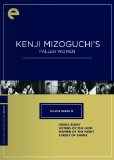| Reviews & Columns |
|
Reviews DVD TV on DVD Blu-ray 4K UHD International DVDs In Theaters Reviews by Studio Video Games Features Collector Series DVDs Easter Egg Database Interviews DVD Talk Radio Feature Articles Columns Anime Talk DVD Savant Horror DVDs The M.O.D. Squad Art House HD Talk Silent DVD
|
DVD Talk Forum |
|
|
| Resources |
|
DVD Price Search Customer Service #'s RCE Info Links |
|
Columns
|
|
|
Kenji Mizoguchi's Fallen Women - Eclipse Series 13
Using mostly the same cast for both films, the 71-minute Osaka Elegy and the 69-minute Sisters of Gion are companion pieces addressing paternalistic oppression within the family and in society respectively. In Osaka Elegy, Ayoko (Isuzu Yamada), a young office worker, feels compelled by the financial needs of her father and brother to become her boss's mistress. Though this affair ruins her marriage prospects with her dashing co-worker Nishimura (Kensaku Hara), Ayoko's weak father and egotistical brother loath her actions while still taking her money. Though Osaka Elegy is admirable as a proto-feminist rebuke of a paternalistic society that demands unquestioning familial sacrifice from women, it's difficult to square this notion of victimization with more modern notions of feminism insomuch as it presumes the protagonist had no alternative but to sacrifice herself. Given that whatever pressures Ayoko felt were strictly internal, one could well hold her accountable for her decisions, yet that notion of independent moral agency on the part of Ayoko is beyond the film's scope.
In the less melodramatic and more earnest Sisters of Gion, Mizoguchi examines the plight of modern geisha through the didactically parallel stories of two sisters: the unsentimentally modern Omocha (Isuzu Yamada) and the demurely traditional Umekichi (Yoko Umemura). Though Omocha and Umekichi try to find financial security and personal happiness along divergent paths, both come to grief at the hands of cruel or indifferent men. Again as with Osaka Elegy, Sisters of Gion portrays its heroines as victims to be pitied rather than as independent moral agents responsible for their choices.
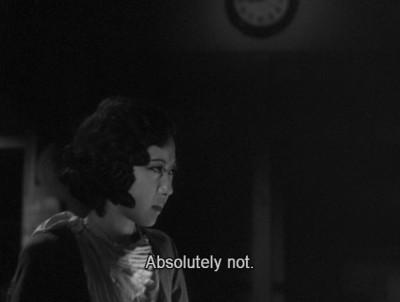
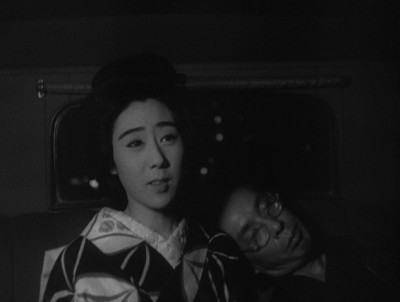
The post-war film Women of the Night blends social realism with exploitation film. Set in post-war Osaka, Women of the Night concerns itself with two sisters suddenly bereft of fathers, husbands, income and social security. The sisters both fall for the same narcotics smuggling misogynist. Prostitution, pregnancy, disease, rape, drug abuse and violence accompany their downward spiral that also drags down a young friend. Ostensibly Women of the Night reveals the depths of post-war destitution among women suddenly orphaned or widowed by war, but in actuality it is frequently salaciously prurient in its exploration of the darker elements of the prostitution, violence and deprivation of its protagonists. Though some of the women in the film are victimizers as well as victims, all are still to be pitied for their lack of control over their actions and circumstances which are forever dictated by the desires and deeds of men.
Street of Shame, Mizoguchi's final film, soberly examines the circumstances of five women who through choice or circumstance find themselves working together in a Tokyo brothel. While two come to prostitution out of dire financial need and find little happiness, three others find prostitution rewarding or at least preferable to any available alternative: one uses prostitution to raise capital to buy a dry goods store; a second uses it to fund a lifestyle of carefree conspicuous consumption; and a third finds it more agreeable than marriage to a poor farmer. Street of Shame is the most ideologically complex and dynamic of the films in this set, and the only one I wholeheartedly recommend.
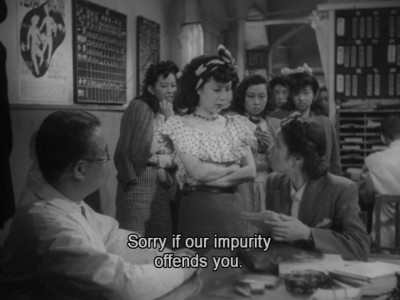
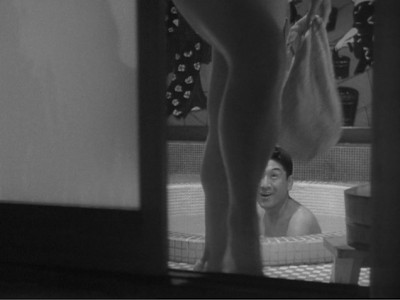
Presentation
This set consists of four single-layered discs housed in separate slimline cases, enclosed in a single cardboard slipcover.
Video:
All four films are presented in their original aspect ratio of 1.33:1. The three older films, Osaka Elegy, Sisters of the Gion, and Women of the Night, suffer from print damage and missing frames. The image frequently flickers, is soft, and suffers from poor contrast. Street of Shame looks significantly better but also suffers from minor print damage and from mild compression errors and noise attributable to or at least exacerbated by the single-layer DVD transfer.
Audio:
All four features are presented in Japanese Dolby Digital mono tracks. All but Street of Shame suffer from recording noise and occasional damage.
Optional English subtitles are as flawless as we've come to expect from the Criterion Collection.
Extras:
Extras are limited to a single page of liner notes printed on the reverse side of the cover for each film.
Final Thoughts:
While I commend the Criterion Collection for releasing these "overshadowed" films from Kenji Mizoguchi that will likely please fans of his better known films The Life of Oharu (Saikaku Ichidai Onna, 1952), Ugetsu (Ugetsu monogatari, 1953), and Sansho the Bailiff (Sanshô dayû, 1954), I wouldn't recommend this set as an introduction to his oeuvre.
While acknowledging the social importance of all of these films in the context of the struggle for sociopolitical modernity through which Japan passed in the 20th century, I find the first three films in this set to require far greater allowances from a modern viewer than do the films of his contemporaries such as Yasujirō Ozu. Accordingly, while this set is recommended for fans, neophytes would do better to start with one of his three better known films of which Ugetsu is probably the best choice in terms of content and presentation (A/V quality and extras).
|
| Popular Reviews |
| Sponsored Links |
|
|
| Sponsored Links |
|
|
| Release List | Reviews | Shop | Newsletter | Forum | DVD Giveaways | Blu-Ray | Advertise |
|
Copyright 2024 DVDTalk.com All Rights Reserved. Legal Info, Privacy Policy, Terms of Use,
Manage Preferences,
Your Privacy Choices | |||||||









